TOYOTA SEQUOIA 2015 2.G Quick Reference Guide
Manufacturer: TOYOTA, Model Year: 2015, Model line: SEQUOIA, Model: TOYOTA SEQUOIA 2015 2.GPages: 27, PDF Size: 2.49 MB
Page 11 of 27
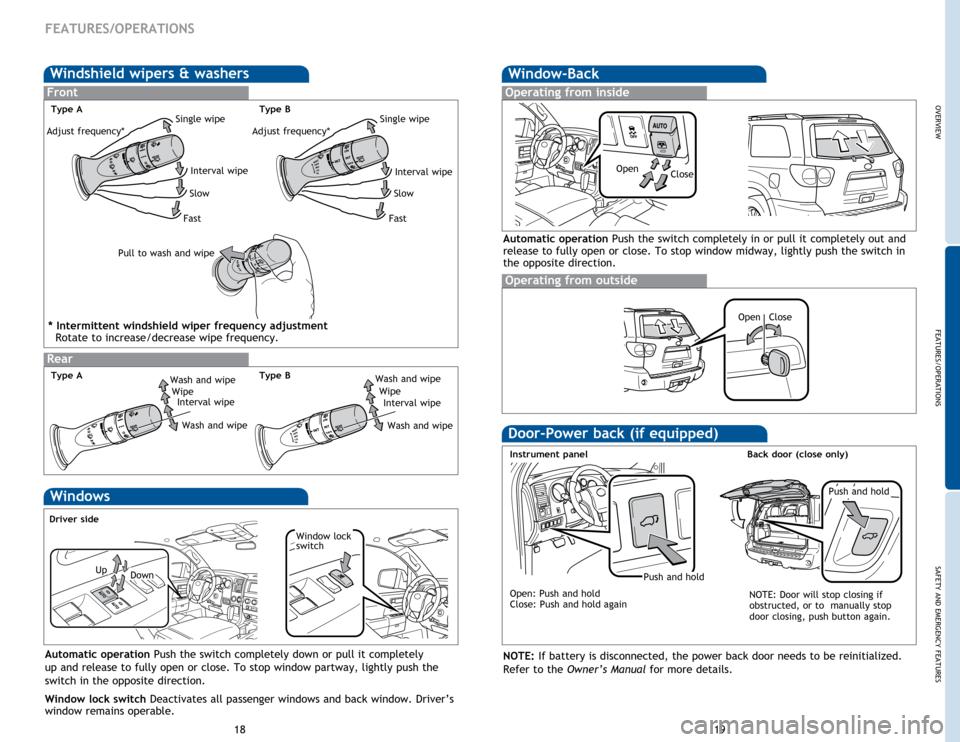
OVERVIEW
FEATURES/OPERATIONS
SAFETY AND EMERGENCY FEATURES
19
18
Windshield wipers & washers
Interval wipe
Single wipe
Slow
Fast
Pull to wash and wipe
Front
Rear
Wash and wipe Wipe Interval wipe
Wash and wipe
FEATURES/OPERATIONS
Windows
Window lock
switch
Automatic operation Push the switch completely down or pull it completely
up and release to fully open or close. To stop window partway, lightly push the
switch in the opposite direction.
Window lock switch Deactivates all passenger windows and back window. Driver’s
window remains operable.
UpDown
Driver side
Window-Back
Operating from inside
Operating from outside
Automatic operation Push the switch completely in or pull it completely out and
release to fully open or close. To stop window midway, lightly push the switch in
the opposite direction.
Open Close
Open Close
Door-Power back (if equipped)
Push and hold
Push and hold
Back door (close only)
Open: Push and hold
Close: Push and hold again
NOTE: If battery is disconnected, the power back door needs to be reinitialized.
Refer to the Owner’s Manual for more details.
Instrument panel
Adjust frequency*
* Intermittent windshield wiper frequency adjustment
Rotate to increase/decrease wipe frequency.
Type A Type B
Interval wipe
Single wipe
Slow
Fast
Adjust frequency*
Type AWash and wipe
Wipe Interval wipe
Wash and wipeType B
NOTE: Door will stop closing if
obstructed, or to manually stop
door closing, push button again.
Page 12 of 27

OVERVIEW
FEATURES/OPERATIONS
SAFETY AND EMERGENCY FEATURES
21
20
Moonroof (if equipped)
Sliding operationTilting operation
OpenTilt
CloseClose
FEATURES/OPERATIONS
Tilt and telescopic steering wheel
Hold wheel, push lever down, set angle and length and return lever.
Manual
Lock release lever
Angle
Toggle the control switch to set angle and length.
NOTE: Do not attempt to adjust while the vehicle is in motion.
Power
Up
Control switch
Away from
the driver Length
Toward the
driver
Down
The VSC OFF switch is used to switch between modes related to the TRAC, VSC
and Auto LSD functions.
Refer to Section 2-4 of the Owner’s Manual for more information.
VSC OFF switch
VSC OFF switch
Push to open/close. To stop partway, press the switch lightly.
Accessory meter
Outside temperature/Cruise information display (if equipped)
Clock
Hour set
Minute set
Change information (if equipped)
“SELECT RESET” button (if equipped)
“SETUP” button to customize unit (if equipped)
Refer to your Owner’s Manual for complete details on this system before
attempting to use it.
Page 13 of 27
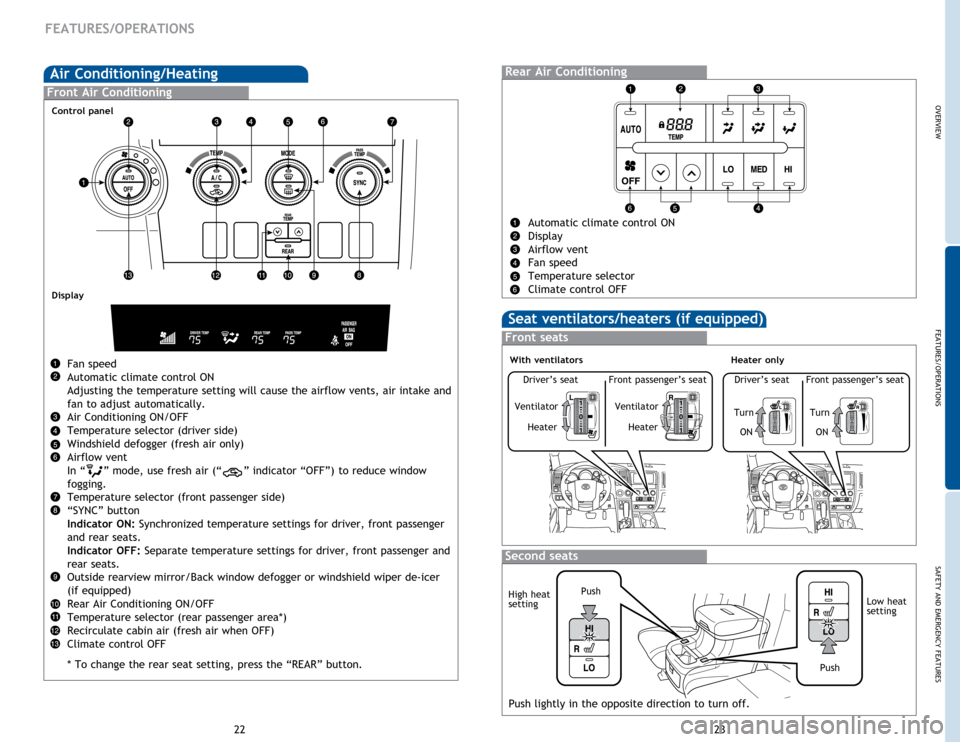
OVERVIEW
FEATURES/OPERATIONS
SAFETY AND EMERGENCY FEATURES
23
22
Front Air Conditioning
Fan speed
Automatic climate control ON
Adjusting the temperature setting will cause the airflow vents, air intake and
fan to adjust automatically.
Air Conditioning ON/OFF
Temperature selector (driver side)
Windshield defogger (fresh air only)
Airflow vent
In “
” mode, use fresh air (“” indicator “OFF”) to reduce window
fogging.
Temperature
selector (front passenger side)
“SYNC” button
Indicator ON: Synchronized temperature settings for driver, front passenger
and rear seats.
Indicator OFF: Separate temperature settings for driver, front passenger and
rear seats.
Outside rearview mirror/Back window defogger or windshield wiper de-icer
(if equipped)
Rear Air Conditioning ON/OFF
Temperature selector (rear passenger area*)
Recirculate cabin air (fresh air when OFF)
Climate control OFF
* To change the rear seat setting, press the “REAR” button.
FEATURES/OPERATIONS
Air Conditioning/HeatingRear Air Conditioning
Automatic climate control ON
Display
Airflow vent
Fan speed
Temperature selector
Climate control OFF
Seat ventilators/heaters (if equipped)
Front seats
Second seats
Ventilator
Driver’s seat Front passenger’s seat
Heater
Ventilator
HeaterTurn
Driver’s seat Front passenger’s seat
ON
Turn
ON
Heater onlyWith ventilators
Push
Push
Control panel
Display
Low heat
setting
High heat
setting
Push lightly in the opposite direction to turn off.
Page 14 of 27

OVERVIEWFEATURES/OPERATIONS
SAFETY AND EMERGENCY FEATURES
25
24
FEATURES/OPERATIONS
Audio
“ ” “ ”
Use to search within the selected audio medium (radio, CD, iPod®, etc.).
“MODE”
Push to turn audio ON and select an audio mode. Push and hold to mute or
pause the current operation.
>>>>
Steering wheel switches (if equipped)
iPod®/USB/AUX port
Touch screen display
Turn to tune
radio stations
manually or
select tracks
or files
Push to turn
ON/OFF
Seek station/
CD track
select
*1 Refer to the “Entune/Navigation System Owner’s Manual
” for instruction.
*2 Entune Premium Audio or Entune Premium JBL Audio
iPod®/USB port
By connecting a USB-compatible portable audio device or USB memory to the
USB port, you can listen to music from the portable audio device or USB memory
through the vehicle’s speaker system.
AUX port
By inserting a mini plug into the AUX port, you can listen to music from a portable
audio device through the vehicle’s speaker system while in AUX mode.
Push to
display audio
screenVolume control
Entune Audio
Entune Premium Audio*1/Entune Premium JBL Audio*1
Eject CD
*2*2
Page 15 of 27
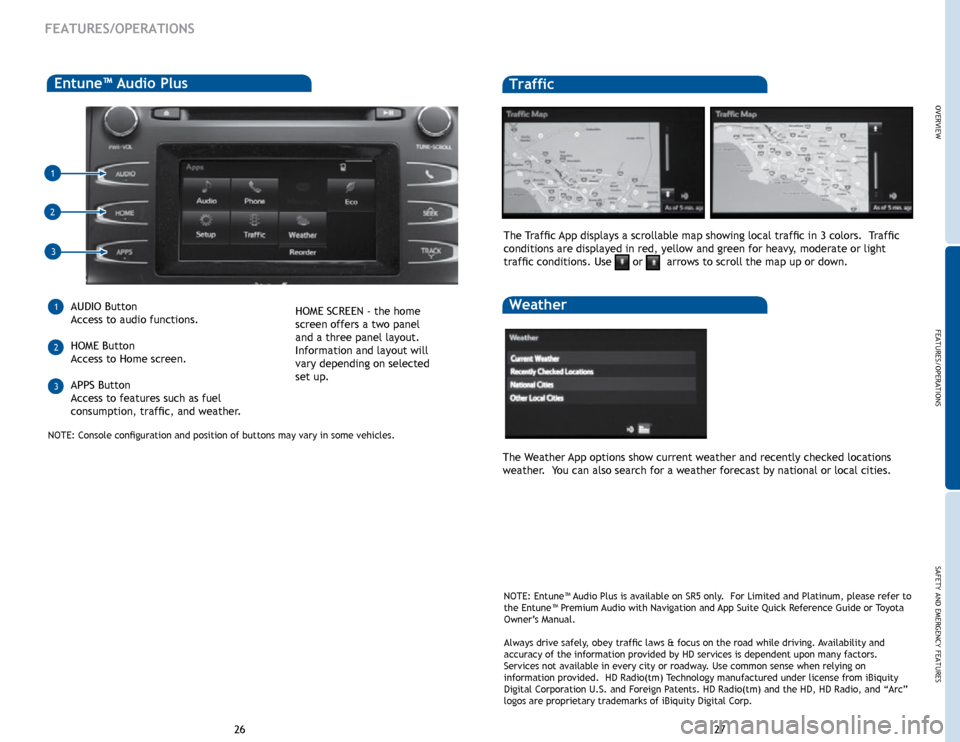
27
26
Entune™ Audio Plus
AUDIO Button
Access to audio functions.
HOME Button
Access to Home screen.
APPS Button
Access to features such as fuel
consumption, traffic, and weather.
1
2
3
1
2
3
Traffic
The Weather App options show current weather and recently checked locations
weather. You can also search for a weather forecast by national or local cities. The Traffic App displays a scrollable map showing local traffic in 3 colors. Traffic
conditions are displayed in red, yellow and green for heavy, moderate or light
traffic conditions. Use
or arrows to scroll the map up or down.
WeatherHOME SCREEN - the home
screen offers a two panel
and a three panel layout.
Information and layout will
vary depending on selected
set up.
NOTE: Entune™ Audio Plus is available on SR5 only. For Limited and Platinum, please refer to
the Entune™ Premium Audio with Navigation and App Suite Quick Reference Guide or Toyota
Owner’s Manual.
Always drive safely, obey traffic laws & focus on the road while driving. Availability and
accuracy of the information provided by HD services is dependent upon ma\
ny factors.
Services not available in every city or roadway. Use common sense when relying on
information provided. HD Radio(tm) Technology manufactured under license from iBiquity
Digital Corporation U.S. and Foreign Patents. HD Radio(tm) and the HD, HD Radio, and “Arc”
logos are proprietary trademarks of iBiquity Digital Corp.
FEATURES/OPERATIONS
NOTE: Console configuration and position of buttons may vary in some vehicles.
FEATURES/OPERATIONS
SAFETY AND EMERGENCY FEATURES
OVERVIEW
Page 16 of 27
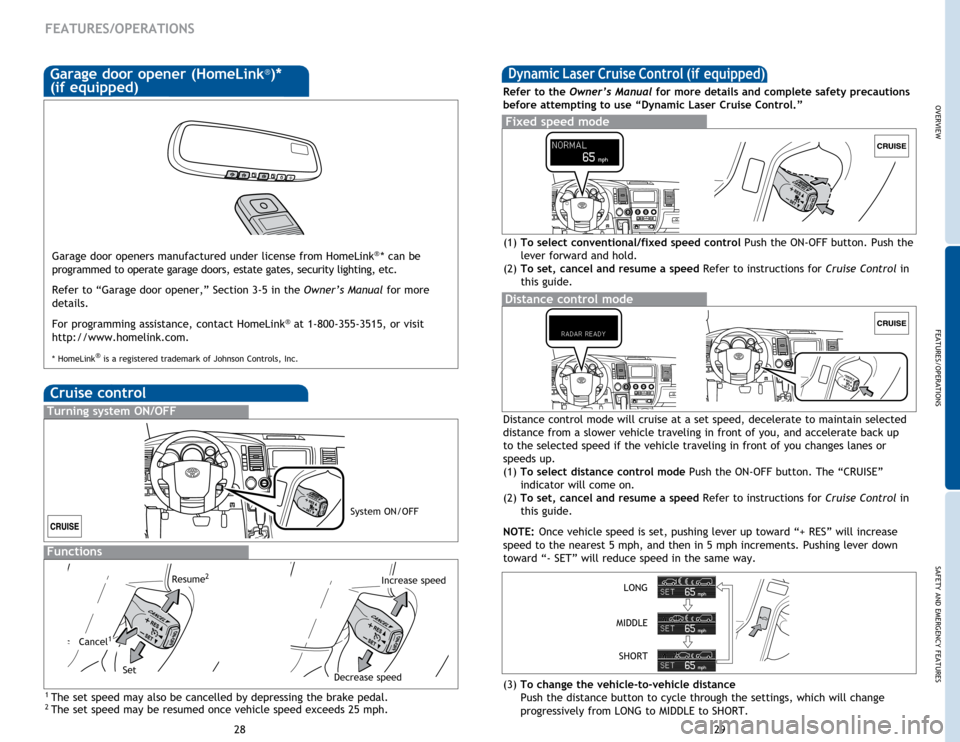
OVERVIEW
FEATURES/OPERATIONS
SAFETY AND EMERGENCY FEATURES
29
28
FEATURES/OPERATIONS
Distance control mode will cruise at a set speed, decelerate to maintain selected
distance from a slower vehicle traveling in front of you, and accelerate back up
to the selected speed if the vehicle traveling in front of you changes lanes or
speeds up.
(1) To select distance control mode Push the ON-OFF button. The “CRUISE”
indicator will come on.
(2) To set, cancel and resume a speed Refer to instructions for Cruise Control in
this guide.
NOTE:
Once
vehicle speed is set, pushing lever up toward “+ RES” will increase
speed to the nearest 5 mph, and then in 5 mph increments. Pushing lever down
toward “- SET” will reduce speed in the same way.
(3) To change the vehicle-to-vehicle distance
Push the distance button to cycle through the settings, which will change
progressively from LONG to MIDDLE to SHORT.
Dynamic Laser Cruise Control (if equipped)
(1) To select conventional/fixed speed control Push the ON-OFF button. Push the
lever forward and hold.
(2) To set, cancel and resume a speed Refer to instructions for Cruise Control in
this guide.
Fixed speed mode
Refer to the Owner’s Manual for more details and complete safety precautions
before attempting to use “Dynamic Laser Cruise Control.”
Distance control mode
LONG
MIDDLE SHORT
Garage door openers manufactured under license from HomeLink®* can be
programmed to operate garage doors, estate gates, security lighting, etc\
.
Refer to “Garage door opener,” Section 3-5 in the Owner’s Manual for more
details.
For programming assistance, contact HomeLink
® at 1-800-355-3515, or visit
http://www.homelink.com.
* HomeLink® is a registered trademark of Johnson Controls, Inc.
Garage door opener (HomeLink®)*
(if equipped)
Cruise control
1 The set speed may also be cancelled by depressing the brake pedal.2 The set speed may be resumed once vehicle speed exceeds 25 mph.
Turning system ON/OFF
Functions
Increase speed
Decrease speed
Cancel1
Resume2
Set
System ON/OFF
Page 17 of 27

OVERVIEW
FEATURES/OPERATIONS
SAFETY AND EMERGENCY FEATURES
31
30
FEATURES/OPERATIONS
Telephone controls (Bluetooth®)
(if equipped)
Door locks
Lock
Unlock
Multi-Information Display (if equipped)
Push “INFO” to change information in the following:
(1) Zoom display of odometer and trip meter
(2) Average gas mileage
(3) Current gas mileage
(4) Miles left on remaining fuel
(5) Running time from engine start
(6) Average vehicle speed
Push “SETUP”
to customize to the following settings:
(1)
UNIT
(2)
KEYLESS ENTRY FEEDBACK
(3)
KEYLESS ENTRY RELOCK TIMER
(4)
KEYLESS ENTRY ALL
DOORS UNLOCK
(5)
DOOR AUTO LOCKING
(6)
DOOR AUTO UNLOCKING
(7)
HEADLAMPS
AUTO OFF TIMER
(8)
COURTESY LAMPS
OFF TIMER
(9)
LANGUAGE
(10)
DEFAULT
SETTING
Bluetooth® technology allows dialing or receipt of calls without taking hands
from the steering wheel or using a cable to connect the compatible telephone
and the system.
Refer to “Using a Bluetooth
® phone” Section 3-2 in the Owner’s Manual, for
more details.
Microphone
Steering wheel telephone switches
Volume
End call
Start call
Voice command
button
Audio unit
Page 18 of 27
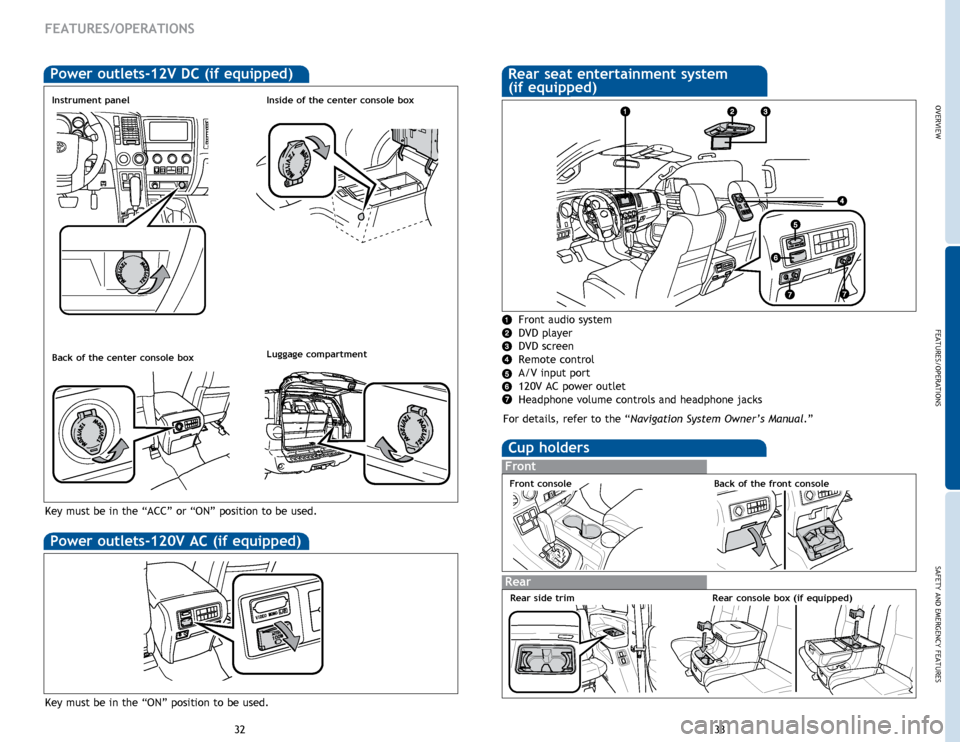
OVERVIEW
FEATURES/OPERATIONS
SAFETY AND EMERGENCY FEATURES
33
32
Cup holders
Front
Rear
Front consoleBack of the front console
Rear console box (if equipped)
FEATURES/OPERATIONS
Power outlets-120V AC (if equipped)
Key must be in the “ON” position to be used.
Power outlets-12V DC (if equipped)
Luggage compartment
Instrument panelInside of the center console box
Back of the center console box
Key must be in the “ACC” or “ON” position to be used .
Rear seat entertainment system
(if equipped)
Front audio system
DVD player
DVD screen
Remote control
A/V input port
120V AC power outlet
Headphone volume controls and headphone jacks
For details, refer to the “Navigation System Owner’s Manual .”
Rear side trim
Page 19 of 27
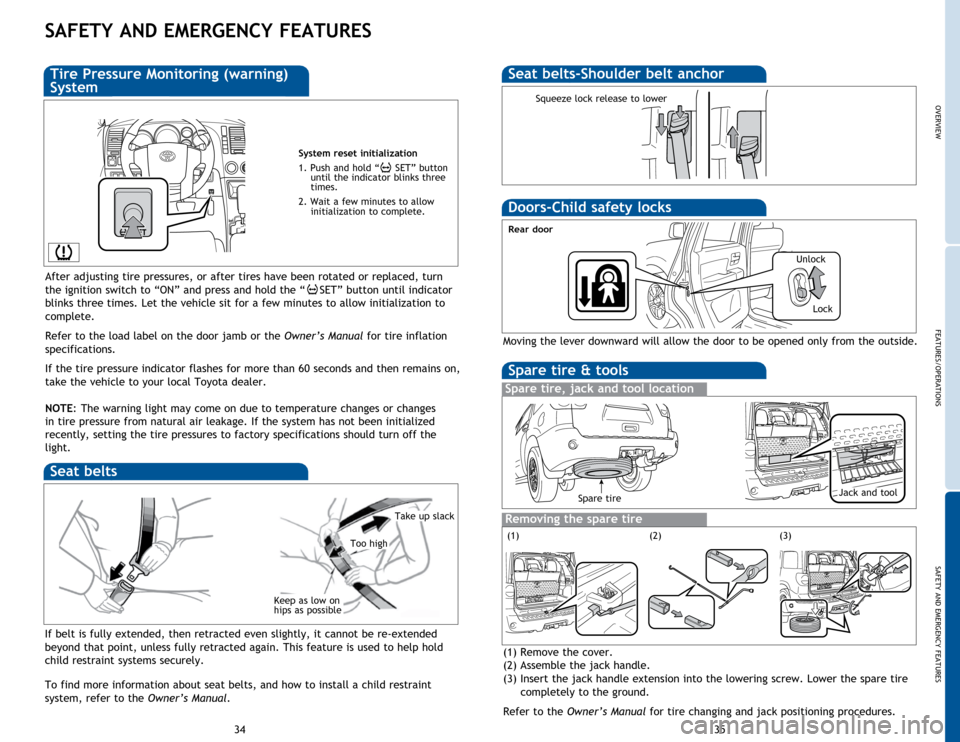
OVERVIEW
FEATURES/OPERATIONS
SAFETY AND EMERGENCY FEATURES
35
34
SAFETY AND EMERGENCY FEATURES
If belt is fully extended, then retracted even slightly, it cannot be re-extended
beyond that point, unless fully retracted again. This feature is used to help hold
child restraint systems securely.
To find more information about seat belts, and how to install a child restraint
system, refer to the Owner’s Manual.
Keep as low on
hips as possible
Take up slack
Too high
Seat belts
System reset initialization
1. Push and hold “
SET” button
until the indicator blinks three
times.
2. Wait a few minutes to allow initialization to complete.
Tire Pressure Monitoring (warning)
System
After adjusting tire pressures, or after tires have been rotated or replaced, turn
the ignition switch to “ON” and press and hold the “
SET” button until indicator
blinks three times. Let the vehicle sit for a few minutes to allow initialization to
complete.
Refer to the load label on the door jamb or the Owner’s Manual for tire inflation
specifications.
If the
tire pressure indicator flashes for more than 60 seconds and then remains on,
take the vehicle to your local Toyota dealer.
NOTE:
The
warning light may come on due to temperature changes or changes
in tire pressure from natural air leakage. If the system has not been initialized
recently, setting the tire pressures to factory specifications should turn off the
light.
Seat belts-Shoulder belt anchor
Squeeze lock release to lower
Spare tire & tools
Spare tire, jack and tool location
Removing the spare tire
(1) Remove the cover.
(2) Assemble the jack handle.
(3) Insert the jack handle extension into the lowering screw. Lower the spare tire
completely to the ground.
Refer to the Owner’s Manual for tire changing and jack positioning procedures.
Moving the lever downward will allow the door to be opened only from the outside.
Rear door
Doors-Child safety locks
(2)(3)
Spare tireJack and tool
(1) Unlock
Lock
Page 20 of 27
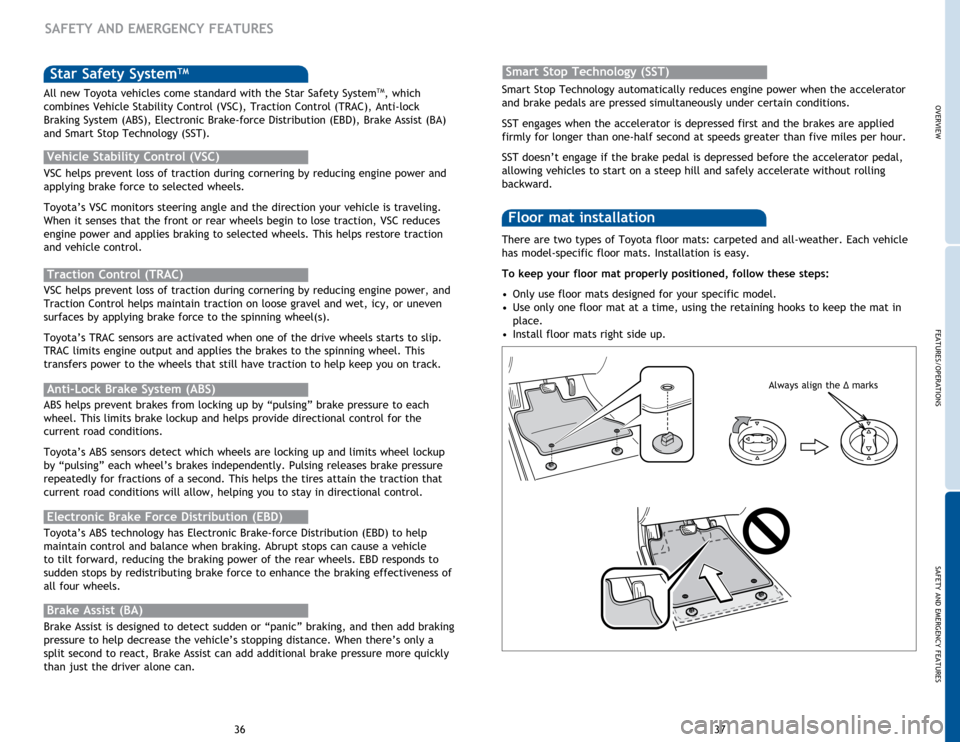
OVERVIEW
FEATURES/OPERATIONS
SAFETY AND EMERGENCY FEATURES
37
36 There are two types of Toyota floor mats: carpeted and all-weather. Each vehicle
has model-specific floor mats. Installation is easy.
To keep your floor mat properly positioned, follow these steps:
•
Only
use floor mats designed for your specific model.
•
Use
only one floor mat at a time, using the retaining hooks to keep the mat in
place.
•
Install
floor mats right side up.
Floor mat installation
SAFETY AND EMERGENCY FEATURES
Smart Stop Technology automatically reduces engine power when the accelerator
and brake pedals are pressed simultaneously under certain conditions.
SST engages when the accelerator is depressed first and the brakes are applied
firmly for longer than one-half second at speeds greater than five miles per hour.
SST doesn’t engage if the brake pedal is depressed before the accelerator pedal,
allowing vehicles to start on a steep hill and safely accelerate without rolling
backward.
Smart Stop Technology (SST)Star Safety SystemTM
VSC helps prevent loss of traction during cornering by reducing engine power and
applying brake force to selected wheels.
Toyota’s VSC monitors steering angle and the direction your vehicle is traveling.
When it senses that the front or rear wheels begin to lose traction, VSC reduces
engine power and applies braking to selected wheels. This helps restore traction
and vehicle control.
Vehicle Stability Control (VSC)
Anti-Lock Brake System (ABS)
ABS helps prevent brakes from locking up by “pulsing” brake pressure to each
wheel. This limits brake lockup and helps provide directional control for the
current road conditions.
Toyota’s ABS sensors detect which wheels are locking up and limits wheel lockup
by “pulsing” each wheel’s brakes independently. Pulsing releases brake pressure
repeatedly for fractions of a second. This helps the tires attain the traction that
current road conditions will allow, helping you to stay in directional control.
Brake Assist (BA)
Brake Assist is designed to detect sudden or “panic” braking, and then add braking
pressure to help decrease the vehicle’s stopping distance. When there’s only a
split second to react, Brake Assist can add additional brake pressure more quickly
than just the driver alone can. VSC helps prevent loss of traction during cornering by reducing engine power, and
Traction Control helps maintain traction on loose gravel and wet, icy, or uneven
surfaces by applying brake force to the spinning wheel(s).
Toyota’s TRAC sensors are activated when one of the drive wheels starts to slip.
TRAC limits engine output and applies the brakes to the spinning wheel. This
transfers power to the wheels that still have traction to help keep you on track.
Traction Control (TRAC)
Electronic Brake Force Distribution (EBD)
Toyota’s ABS technology has Electronic Brake-force Distribution (EBD) to help
maintain control and balance when braking. Abrupt stops can cause a vehicle
to tilt forward, reducing the braking power of the rear wheels. EBD responds to
sudden stops by redistributing brake force to enhance the braking effectiveness of
all four wheels. All new Toyota vehicles come standard with the Star Safety System
TM, which
combines Vehicle Stability Control (VSC), Traction Control (TRAC), Anti-lock
Braking System (ABS), Electronic Brake-force Distribution (EBD), Brake Assist (BA)
and Smart Stop Technology (SST).
Always align the Δ marks